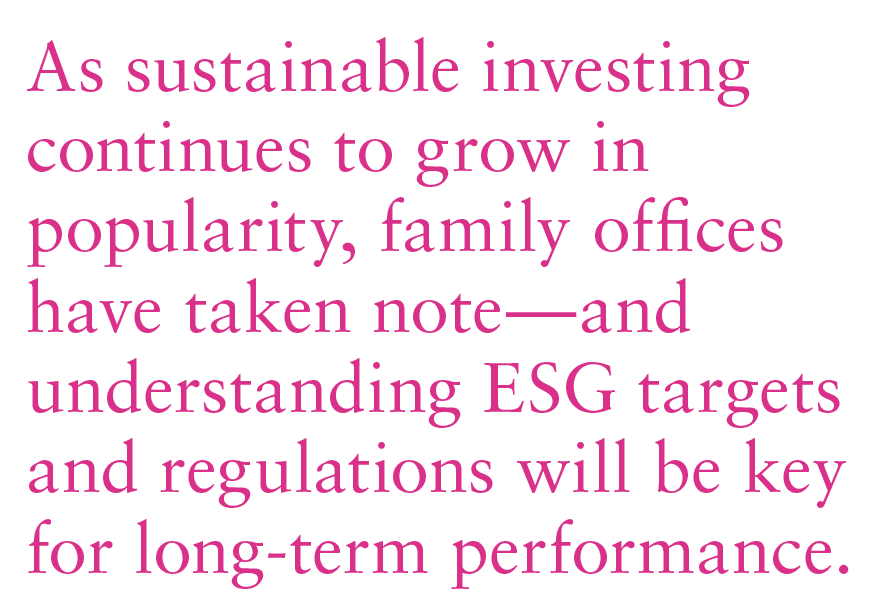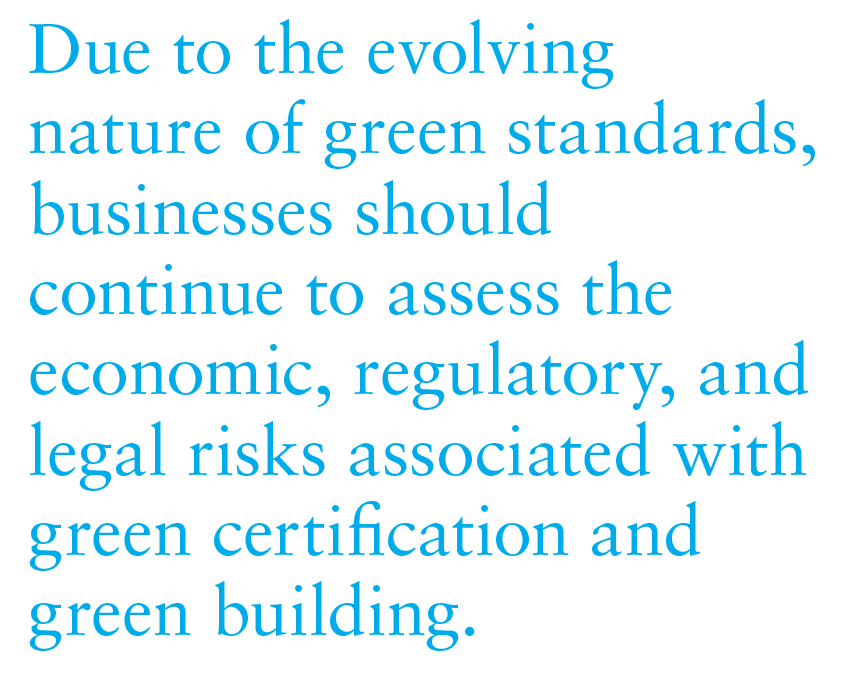As sustainable investing continues to grow in popularity, family offices have taken note.
Investor surveys indicate that more and more respondents take the non-financial performance of a company into consideration in their investments, which include environmental, social and governance (ESG) strategies. Of the most important ESG criteria to investors, green building certification ranked as the top.1
US REGULATORY FRAMEWORK
Green certifications can serve to signify a building’s environmental friendliness and stewardship. In the 1990s, the Building Research Establishment’s Environmental Assessment Method (BREEAM) rating system was established, which utilizes third-party certification to assess an asset’s ESG performance.2 This system was established in the UK but is recognized internationally for its ability to assess the environmental performance of both new and existing properties.
With respect to green building within the US, the US Green Building Council (USGBC) was established in 1993. By the late 1990s, USGBC had established its first version of a green building rating system for green building design, construction, and operation, which is known as Leadership in Energy and Environmental Design (LEED).3 The last few decades have seen an increase in green building certification popularity.
Over time, hundreds of different green certifications have been established. However, it is important to choose a legitimate, widely accepted and tailored green certification. Facilities seeking green certification should generally consider programs that are third party certified, which means that an independent party with no interest or financial ties to the project has made the determination.
Furthermore, green certification programs that are most widely accepted include some type of ongoing verification of certification compliance. For example, LEED recertification allows a project previously certified under LEED to submit twelve months of data and receive recertification valid for three years. By encouraging recertification, these programs ensure that real estate continues to demonstrate environmental and energy sustainability over time. Notably, a decision on which green certification(s) to seek may largely be driven by which types of certifications investors deem important.

One reason that the role of certification is often undertaken by third-party programs is that no centralized governmental agency in the US is tasked with determining green certification. Some states have established their own recognition programs for implementation of environmentally friendly and pollution reducing activities. For example, the Ohio Environmental Protection Agency (Ohio EPA) has established its “Encouraging Environmental Excellence (E3) Program,” which recognizes Ohio businesses for their environmental stewardship.4 Under this program, businesses submit an application providing information on a number of criteria, including sustainable materials and purchasing, pollution prevention, energy efficiency, green building, and renewable energy.
Outside of these voluntary green certification programs, several states have established or are in the process of establishing green building requirements. For example, California passed Senate Bill 32, which requires statewide greenhouse gas (GHG) emissions to reach a level 40% below 1990 levels by 2030.5 California legislators and regulators believe that an important component of lowering GHG emissions is through building decarbonization. As a result, the California Air Resources Board (CARB) is focusing on advancing “zero emission buildings,” which includes statewide strategies for building standards codes, as well as encouraging a voluntary effort to go beyond mandatory code requirements.
Similarly, the New York City Council passed legislation, known as the Climate Mobilization Act, to reduce GHGs and improve energy efficiency for New York City buildings.6 In part, the legislation establishes emissions caps for buildings over 25,000 SF and roofs of smaller, new residential and non-residential buildings will be equipped with a solar photovoltaic system or a green roof.
As the regulatory scheme for green building continues to evolve, interested persons need to be aware of potential areas for risk and liability. For example, green building requirements may change over time and in some instances, may become mandatory. A change in the degree of regulation may impact a business both economically and legally.
With respect to the more voluntary programs for certification, such as LEED, interested parties need to ensure that they maintain such certification and do not advertise such certification without ensuring consistent and continued compliance. As green regulations become more common, there is also a risk that these regulatory programs will contradict or be inconsistent with those more voluntary programs. Due to the evolving nature of green standards, businesses should continue to assess the economic, regulatory, and legal risks associated with green certification and green building.
CONSIDERATIONS FOR OWNERS OF REAL ESTATE
Owners of real estate assets can incorporate ESG in a property’s design and operation by obtaining green certifications. Not only can such certifications reduce maintenance costs for owners, but certifications also attract certain prospective tenants and buyers who want to factor ESG into their investments.

In addition to certifications, ESG criteria can be tracked during the period of ownership of property by the selection of third-party property managers who will monitor the property in accordance with such criteria, whether by agreeing to minimum monitoring standards or via incentive fees to reward meeting set ESG targets. In addition to demonstrating that a property is well managed, identifying and tracking ESG during the period of ownership limits unforeseen risk at the time of disposition of the property that could affect purchase prices. It follows, then, that attention to sustainability efforts could increase property values long-term.7
Aside from incentivizing the development of eco-friendly buildings, the impact of ESG investing in the real estate industry could even extend to rethinking the way that communities are developed. Affordable housing and environmentally sustainable, well-connected neighborhoods have proven to deliver impressive returns to investors, and indicate the potential for a new, and profitable, approach to urban development.8
Additionally, real estate owners can incorporate ESG concepts into individual tenant lease agreements in various ways. For instance, owners can require that tenants cooperate with the owner/landlord in obtaining and maintaining compliance with the owner’s green certifications, and, increasingly, laws regarding carbon neutrality for buildings. The owner/landlord may require that tenants participate in a recycling program or have each tenants’ utilities sub-metered to monitor usage. Leases may even contain use restrictions that range from prohibiting gas stations in retail shopping center developments to requiring office tenants to use only “clean” dry-cleaning services.
Incorporating ESG into leases can be a win-win to both landlords and tenants, as landlords can pass through capital expenditure costs on ESG projects or green certifications to tenants, while tenants can receive the benefit of the cost-savings on their utility or operating expense payments.
Increased state and local programs encouraging and/ or requiring green building requirements indicate the growing importance of green building to owners of real estate assets. As real estate owners, buyers, and tenants continue to consider a building’s environmental stewardship and sustainability efforts, green certification, in addition to other ESG criteria, will be at the forefront of investment decisions.
—
ABOUT THE AUTHORS
Kate Pennartz is a Partner and Rebekah Singh is a Senior Associate for Squire Patton Boggs, a full-service global law firm providing insight at the point where law, business, and government meet.
—
NOTES
1 Wealth Management Real Estate, “10 Takeaways from AFIRE’s 2021 International Investor Survey,” WealthManagement.com, last modified May 04, 2021, wealthmanagement.com/investment-strategies/10-takeaways-afire-s-2021-internationalinvestor-survey.
2 BREEAM, “Building Research Establishment’s Environmental Assessment Method,” BREEAM, accessed October 24, 2021, breeam.com/.
3 US Green Building Council, “US Green Building Council,” USGBC, Accessed October 24, 2021, usgbc.org/.
4 Ohio EPA, “Encouraging Environmental Excellence (E3) Program,” Ohio Environmental Protection Agency, Accessed October 24, 2021, epa.state.oh.us/ocapp/ohioe3.
5 California Air Resources Board, “Building Decarbonization: About,” California Air Resources Board, Accessed October 24, 2021, arb.ca.gov/our-work/programs/building-decarbonization/about.
6 New York City Council, “Climate Mobilization Act,” New York City Council, Accessed October 24, 2021, council.nyc.gov/data/green/.
7 Francisco Da Cunha and Filipa Belchior Coimbra, “The Impact of Social Good on Real Estate,” Deloitte Real Estate Predictions 2021, Accessed October 24, 2021, deloitte.com/ce/en/pages/real-estate/articles/the-impact-of-social-good-on-realestate.html.
8 Steven Desmyter, “What if ESG Could Solve the Global Housing Crisis?” Forbes, last modified May 25, 2021, forbes.com/sites/stevendesmyter/2021/05/25/whatif-esg-could-solve-the-global-housing-crisis/?sh=3e2ca18e1201.
ALSO IN THIS ISSUE (FALL 2021)
NOTE FROM THE EDITOR / GROUPTHINK VS. GROUP COLLABORATION
AFIRE | Benjamin van Loon
MID-YEAR SURVEY / CHECKING THE PULSE
No matter your age or experience, 2021 has shaped up to be a year that no one can forget. Findings from the AFIRE 2021 Mid-Year Pulse Survey detail a cautious road ahead.
AFIRE | Gunnar Branson and Benjamin van Loon
CLIMATE CHANGE / REASSESSING CLIMATE RISK
The commercial real estate industry may not yet fully grasp the actual relationship between climate risk and asset pricing and value. But the knowledge is coming fast.
York University | Jim Clayton
University of Reading | Steven Devaney and Jorn Van de Wetering
Kinston University | Sarah Sayce
UNEP FI | Matthew Ulterino
NON-TRADITIONAL / THE ALLURE OF SPECIALTY SECTORS
Real estate investments have historically coalesced around common property types—but it may make sense for investors to reconsider specialty property sectors in the post-COVID world.
Invesco Real Estate | David Wertheim
NON-TRADITIONAL / NON-TRADITIONAL IS GOING MAINSTREAM
The mainstreaming of nontraditional property types is well on its way within institutional investing, which will materially broaden the real estate investment universe.
Principal Real Estate Investors | Indraneel Karlekar, PhD
DIGITAL INFRASTRUCTURE / DIVERSIFYING INTO DIGITAL
As investors look for sustainable sources of inflation-protected yield, real estate investment is increasingly blurring into a wider range of “digital” real asset investment strategies.
AECOM Capital | Warren Wachsberger, Josh Katzin, and Corbett Kruse
LIFE SCIENCES / TAPPING INTO BIOTECH
Over the past two decades, the single-family rental industry haLife sciences real estate has been a “hot” property type for the past decade—and even more since the pandemic. Will all the capital targeting the space be placed where it needs to go?
RCLCO | William Maher, Ben Maslan, and Cecilia Galliani
ESG + CLIMATE CHANGE / HIGH-WATER MARKS
Interest and excellence in ESG performance is becoming increasingly critical to portfolio strategy. So with sea levels on the rise, how can portfolios stay above water?
Barings Real Estate | Jerry Speltz
ESG + NET-ZERO / VALUING NET-ZERO
With more tenants focusing on environmental targets, the burden to reduce direct emissions places increased pressure on investors, who are at a pivotal moment in ESG strategy.
JLL | Lori Mabardi, Emily Chadwick, and Eric Enloe
ESG + FAMILY OFFICE / FAMILY OFFICES AND ESG
As sustainable investing continues to grow in popularity, family offices have taken note—and understanding ESG targets and regulations will be key for longterm performance.
Squire Patton Boggs | Kate Pennartz and Rebekah Singh
DEBT / WHY DEBT, WHY NOW?
Debt funds remain a comparatively small part of the real estate investment market, but they have been gaining in prominence in recent years.
USAA Real Estate | Karen Martinus, Mark Fitzgerald, CFA, and Will McIntosh, PhD
MIGRATION / MIGRATION IN REAL TIME
As the public health situation started to improve in early 2021 and the economy reopened, did migration flows change too—and what if we are able to answer this in real time?
Berkshire Residential Investments | Gleb Nechayev
StratoDem Analytics | Michael Clawar
URBANISM / DOWNTOWN DISRUPTION
The pandemic-driven changes to downtown areas and central business districts is changing the geography of institutional investment. What else changes because of this?
Drexel University | Bruce Katz
FBT Project Finance Advisors + Right2Win Cities | Frances Kern Mennone
WORK-FROM-HOME / CHOOSING FLEXIBILITY
Employees are increasingly demanding flexibility and choice for where (and when) they work. What strategies can landlords implement to adapt?
Union Investment Real Estate | Tal Peri
TALENT AND RECRUITMENT / TALENT PARITY
To be better prepared for future risks, firms need diverse talent. So is the goal of 50% female representation achievable in global real estate investment and asset management firms?
Sheffield Haworth | Isabel Ruiz
CLIMATE CHANGE / PREDICTING THE CLIMATE FUTURE
We are all invested in the cities, assets, and infrastructure of tomorrow, even if we might not live to see the ten largest cities in 2100. But understanding climate change can get us closer.
Climate Core Capital | Rajeev Ranade and Owen Woolcock


